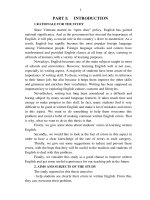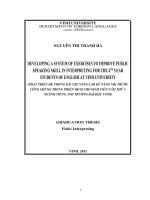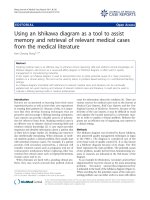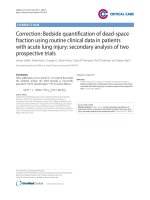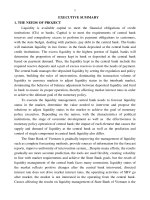Using cooperative learning principles in structuring groups to enhance participation speaking lessons of second-year College students of English at Thanh Do University
Bạn đang xem bản rút gọn của tài liệu. Xem và tải ngay bản đầy đủ của tài liệu tại đây (232.96 KB, 4 trang )
VIETNAM NATIONAL UNIVERSITY
UNIVERSITY OF LANGUAGES AND INTERNATIONAL STUDIES
FACULTY OF POST-GRADUATE STUDIES
.....................o0o.....................
QUÁCH THỊ TUYẾT THANH
USING COOPERATIVE LEARNING PRINCIPLES IN
STRUCTURING GROUPS TO ENHANCE PARTICIPATION IN
SPEAKING LESSONS
OF SECOND-YEAR COLLEGE STUDENTS OF ENGLISH
AT THÀNH ĐÔ UNIVERSITY
(Sử dụng các nguyên lý học hợp tác vào việc tổ chức nhóm nhằm phát
huy mức độ tham gia trong các giờ học nói của sinh viên tiếng Anh năm
thứ hai hệ cao đẳng, trường Đại học Thành Đô)
M.A. MINOR PROGRAMME THESIS
Field: English Teaching Methodology
Code: 60. 14. 10
Hanoi, 2010
VIETNAM NATIONAL UNIVERSITY
UNIVERSITY OF LANGUAGES AND INTERNATIONAL STUDIES
FACULTY OF POST-GRADUATE STUDIES
.....................o0o.....................
QUÁCH THỊ TUYẾT THANH
USING COOPERATIVE LEARNING PRINCIPLES IN
STRUCTURING GROUPS TO ENHANCE PARTICIPATION IN
SPEAKING LESSONS
OF SECOND-YEAR COLLEGE STUDENTS OF ENGLISH
AT THÀNH ĐÔ UNIVERSITY
(Sử dụng các nguyên lý học hợp tác vào việc tổ chức nhóm nhằm phát
huy mức độ tham gia trong các giờ học nói của sinh viên tiếng Anh năm
thứ hai hệ cao đẳng, trường Đại học Thành Đô)
M.A. MINOR PROGRAMME THESIS
Field: English Teaching Methodology
Code: 60. 14. 10
Supervisor: Dr. Nguyễn Huy Kỷ
Hanoi, 2010
TABLE OF CONTENT
CANDIDATE’S STATEMENT ........................................................................................ 1
ACKNOWLEDGEMENTS ............................................................................................... 2
ABSTRACT ...................................................................................................................... 3
LIST OF ABBREVIATIONS ............................................................................................ 4
LIST OF TABLES ............................................................................................................ 5
PART 1: INTRODUCTION .............................................................................................. 8
1
A review of related researches ................................................................................ 8
2
Rationale .............................................................................................................. 10
3
Objectives of the study.......................................................................................... 11
4
Research questions ............................................................................................... 11
5
Significance of the study ....................................................................................... 11
6
Scope of the study................................................................................................. 11
7
Methods of the study ............................................................................................ 12
8
Organization of the study ...................................................................................... 12
PART 2: DEVELOPMENT............................................................................................. 13
CHAPTER 1: THEORETICAL BACKGROUND ................................................ 13
1.1
Cooperative Learning .................................................................................... 13
1.1.1
Definitions of cooperative learning ......................................................... 13
1.1.2
Principles of cooperative learning ........................................................... 14
1.2
Cooperative language learning (CLL) ............................................................ 17
1.2.1
Goals of CLL .......................................................................................... 17
1.2.2
Advantages of CLL ................................................................................ 18
1.2.3
Design of CLL ........................................................................................ 18
1.3
Speaking skill ................................................................................................ 20
1.3.1
Nature of speaking .................................................................................. 20
1.3.2
Classroom speaking performance............................................................ 21
1.3.3
Speaking activities .................................................................................. 22
CHAPTER 2: PRACTICAL RESEARCH ............................................................ 24
2.1
Research methods .......................................................................................... 24
2.1.1
Subjects of the research .......................................................................... 24
2.1.2
Procedure of the research ........................................................................ 24
2.1.3
Instrumentation and data collection ......................................................... 27
2.2
Data Analysis ................................................................................................ 28
2.2.1
Data analysis procedure .......................................................................... 28
2.2.2
Data analysis results ............................................................................... 29
2.3
Discussion of the research questions .............................................................. 36
2.3.1
What are the effects of CL on students’ participation in the group
activities? ............................................................................................................. 36
2.3.2
What are the students’ attitudes towards CL? .......................................... 38
CHAPTER 3: IMPLICATIONS............................................................................ 40
3.1
The CL training and implementation plan ...................................................... 40
3.2
Dealing with the problems of CL application ................................................. 42
3.3
Teachers’ awareness of their roles in CL lessons ............................................ 42
PART 3: CONCLUSION ................................................................................................ 44
1. The achievement of the objectives of the study ................................................ 44
2. The effectiveness of the methods and instruments used .................................... 44
3. Limitations of the study ................................................................................... 45
4. Suggestions for further studies ......................................................................... 46
REFERENCES................................................................................................................ 47
APPENDICES ........................................................... Error! Bookmark not defined.- VII


